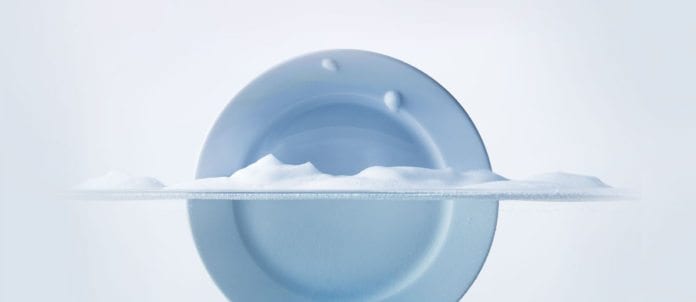Many warewashers last longer than most relationships, so foodservice operators need to make sure they’re up for the 25-year commitment and capitalize on new machine technologies that are saving time, money and energy.
Mike Higgins, owner of Higgins Event Rentals in Toronto, agrees. Finding warewashers that work well turned out to be the biggest saving he has realized in his 30 years of business. “Our old systems used lots of water,” he explains. “We had to put loads through two to three times just to get good results. It’s hard to make money when people are washing dishes three times as much as they should be.”
When he bought his first German-designed Meiko system, he noticed a big difference. “I waited 20 years for the industry to come up with something like this. Everything was sparkling clean the first time, and it used a lot less water and energy and didn’t create water pressure problems. The first one I bought blew me away so much I bought a second one,” he says.
The water and energy savings is huge, especially since his machines — which cost $40,000 each — run non-stop, eight hours a day. “We clean way more dishes than any restaurant,” Higgins claims. “Durability is a big thing for us.”
Another important consideration is chemical setup. “The first chemicals we used didn’t work well. Once we looked into a new supplier, the difference with having the right product was like night and day,” adds Higgins. With the correct setup and maintenance, Higgins estimates the equipment will last for some time. “As long as you keep the seals from leaking water and replace pumps once in a while, they should go on forever. They paid for themselves in year one,” he says.
The culinary team at The Fairmont Royal York hotel in Toronto would likely agree. According to Calvin Vick, director of Engineering, the decision was made to buy three new Champion machines to replace 25-year-old warewashers that were used to service the hotel’s restaurant and banquet facilities. The recently installed flight dishwashers cost $130,000 apiece. One is used for Epic Restaurant, room service and the Library Bar, while the other two are housed side-by-side near the banquet and convention space (one of the two is primarily used for glassware to prevent cross-contamination). “Our old machines were kept together by Band-Aids and railing wire,” Vick jokes. “We could barely keep them going, and they were very inefficient. In getting new ones, we wanted to get all the energy-efficiency we could.”
The flight units, which don’t use racks, average 25 feet in length and feature a rotating conveyor belt. “We went through an elaborate study on what to buy,” Vick says. “We went to factories and other hotels to see what worked best. There’s a lot of moving parts on these things, so they really need to stand up.”
The machines also have digital monitoring that keeps track of the rinse cycles, volumes, temperatures and other data, and they can be linked to a remote panel for monitoring from an office location. The Royal York team is also planning to add heat-recovery systems once things are up and running completely.
The new Champions at the hotel use 132 gallons per hour compared to the previous rate of 342 gallons. “That’s a 61-per-cent savings in water usage,” Vick notes.
In fact, the units can run in three different settings, so operators can increase the speed of the conveyor and manage water demand. For example, the energy-saving mode runs at eight feet per minute and uses 84 gallons of water per hour. During the busiest times, the express mode consumes 123 gallons of water at a conveyor speed of 12.4 feet per minute. “One thing that sold us with this system is the energy-efficiency mode,” Vick says.
Another key energy- and water-savings feature is the built-in sensors, which will automatically turn water on and off when items are entering and leaving. “The pumps won’t operate if dishes are not going through,” Vick explains. “That’s where a lot of the [water and energy] savings are.”
There are a few custom features of note with regard to the systems used at the Royal York, adds Michael Grandy, chief steward. For example, each has four tanks compared to the three typically found on a machine. (The additional tank is used for pre-washing.) Each tank shuts down once something passes through, and the final rinse doesn’t start until the end of the cycle. “There’s less spray and condensation, and the tanks don’t fill up as much. It also cuts down on chemical and water usage,” Grandy says.
The models have a slightly different configuration to serve a specific function and footprint. The glassware system, for example, is narrower. The Royal York’s second banquet warewasher is slightly wider to accommodate oval trays, while the main floor restaurant system is three feet shorter to fit a smaller space. The warewashing machine footprint is also a primary concern for Sean Bayley of FAB Concepts Inc., especially when he’s choosing new machines for the Toronto-based restaurant company’s Mill Street Brew Pub and Against the Grain Urban Tavern locations. “There’s never enough space for anything,” Bayley says. “But you need speed as well, because we go through a lot of glassware.”
Bayley is always looking for new engineering ideas to conserve energy and water. His latest Apex warewashers are leased from Mississauga, Ont.’s Ecolab and operate on a 1.2-gallon-per-minute (gpm) cycle to conserve water. (Older systems will typically run at 3.5 to 4 gpm, so the new machine offers a 75-per-cent reduction in water and chemical usage.) “The big saving is about the chemicals. Instead of having to keep 16- or 20-litre pails under the dishwasher, everything is in small pucks, which doesn’t take up as much storage space,” Bayley explains.
In addition to a conveyor system in the back, FAB’s Mill Street and Against the Grain restaurant locations have an under-the-counter glassware washer that can cycle items through in 30 seconds and hold 100 glasses at a time. Having a separate washing system is important at a brew pub, since glasses can be too fragile for a conveyor. “But it’s mostly because you don’t want food specks on the glasses. That’s very bad for business,” Bayley says.
What’s good for business is the machine’s heat-recovery system, which is used to reheat water. And, the machine’s digital-monitoring system tracks chemical, energy and water usage, making it easier to monitor energy savings. “You need to make sure your warewashers are full and utilize the ideal amount of chemical, energy and water. That’s important,” says Bayley.





















